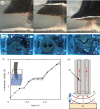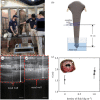Suction feeding by elephants - PubMed (original) (raw)
Suction feeding by elephants
Andrew K Schulz et al. J R Soc Interface. 2021 Jun.
Abstract
Despite having a trunk that weighs over 100 kg, elephants mainly feed on lightweight vegetation. How do elephants manipulate such small items? In this experimental and theoretical investigation, we filmed elephants at Zoo Atlanta showing that they can use suction to grab food, performing a behaviour that was previously thought to be restricted to fishes. We use a mathematical model to show that an elephant's nostril size and lung capacity enables them to grab items using comparable pressures as the human lung. Ultrasonographic imaging of the elephant sucking viscous fluids show that the elephant's nostrils dilate up to [Formula: see text] in radius, which increases the nasal volume by [Formula: see text]. Based on the pressures applied, we estimate that the elephants can inhale at speeds of over 150 m s-1, nearly 30 times the speed of a human sneeze. These high air speeds enable the elephant to vacuum up piles of rutabaga cubes as well as fragile tortilla chips. We hope these findings inspire further work in suction-based manipulation in both animals and robots.
Keywords: muscular hydrostat; object manipulation; suction.
Figures
Figure 1.
An elephant uses suction to pick up lightweight objects. (a) The trunk of an African elephant, showing its two prehensile ‘fingers’ at the tip of the trunk. Scale bar, 5 cm. (b) A regime diagram for suction across number and size of food items. The red symbols indicate the use of suction and black symbols indicate the absence of suction. The cube-shaped objects are rutabaga cubes and the circular object is a tortilla chip. (c) Elephant picking up ten 16 mm rutabaga cubes using suction. (d) Elephant using suction to levitate a tortilla chip into its grip. (e) Elephant pressing its trunk against a tortilla chip and applying suction to pick it up.
Figure 2.
Suction of water. (a) Side view of the elephant siphoning a solution of water mixed with chia seeds acting as flow tracers. Points closest to the nostrils experience the highest speed flow as shown by the trajectory of the chia seeds. Scale bar, 5 cm. (b) Bottom view of elephant siphoning water and closing the trunk to hold the water. Scale bar, 3 cm. (c) Time course of the water flow rate Q. Closed points indicating mean values, and shaded regions show standard deviation. (d) Schematic of a elephant trunk applying suction to a flat object of mass m t. The red arrows denoted the direction of flow. Nostrils of radius a generate a pressure of _P_0, which generates a flow _u_0 in the nasal cavity, and a flow u outside the trunk which rapidly decays with distance L.
Figure 3.
Measurement of nasal wall diameter by ultrasonographic imagery. (a) Set-up for ultrasonographic measurement. (b) Schematic diagram of ultrasonographic measurements collection site. Illustrated by B. Seleb. (c) Ultrasonic image of nasal wall during suction of water. Scale bar, 1 cm. (d) Ultrasonic image of suction of bran water. Scale bar, 1 cm. (e) Relationship between nasal radius r and density of fluid inhaled.
Figure 4.
Predicted suction feeding across terrestrial animals. (a) Relationship between nostril radius and body mass, with power law fit shown by the red line. (b) Relationship between body mass and the theoretical distance L c to pick up a tortilla chip. Animal portraits from Adobe Creative Studio.
Similar articles
- Elephant trunks form joints to squeeze together small objects.
Wu J, Zhao Y, Zhang Y, Shumate D, Braccini Slade S, Franklin SV, Hu DL. Wu J, et al. J R Soc Interface. 2018 Oct 24;15(147):20180377. doi: 10.1098/rsif.2018.0377. J R Soc Interface. 2018. PMID: 30355805 Free PMC article. - Skin wrinkles and folds enable asymmetric stretch in the elephant trunk.
Schulz AK, Boyle M, Boyle C, Sordilla S, Rincon C, Hooper S, Aubuchon C, Reidenberg JS, Higgins C, Hu DL. Schulz AK, et al. Proc Natl Acad Sci U S A. 2022 Aug 2;119(31):e2122563119. doi: 10.1073/pnas.2122563119. Epub 2022 Jul 18. Proc Natl Acad Sci U S A. 2022. PMID: 35858384 Free PMC article. - The trunk replaces the longer mandible as the main feeding organ in elephant evolution.
Li C, Deng T, Wang Y, Sun F, Wolff B, Jiangzuo Q, Ma J, Xing L, Fu J, Zhang J, Wang S. Li C, et al. Elife. 2024 Jun 20;12:RP90908. doi: 10.7554/eLife.90908. Elife. 2024. PMID: 38900028 Free PMC article. - When elephants fall asleep: A literature review on elephant rest with case studies on elephant falling bouts, and practical solutions for zoo elephants.
Schiffmann C, Hoby S, Wenker C, Hård T, Scholz R, Clauss M, Hatt JM. Schiffmann C, et al. Zoo Biol. 2018 May;37(3):133-145. doi: 10.1002/zoo.21406. Epub 2018 Mar 30. Zoo Biol. 2018. PMID: 29600558 Review. - Long-distance, low-frequency elephant communication.
Garstang M. Garstang M. J Comp Physiol A Neuroethol Sens Neural Behav Physiol. 2004 Oct;190(10):791-805. doi: 10.1007/s00359-004-0553-0. Epub 2004 Sep 2. J Comp Physiol A Neuroethol Sens Neural Behav Physiol. 2004. PMID: 15349746 Review.
Cited by
- Measuring the force of the tip of the elephants trunk.
Cornette R, Delapré A, Houssin C, Mulot B, Pouydebat E. Cornette R, et al. MethodsX. 2022 Oct 31;9:101896. doi: 10.1016/j.mex.2022.101896. eCollection 2022. MethodsX. 2022. PMID: 36385915 Free PMC article. - Maximum trunk tip force assessment related to trunk position and prehensile 'fingers' implication in African savannah elephants.
Costes P, Delapré A, Houssin C, Mulot B, Pouydebat E, Cornette R. Costes P, et al. PLoS One. 2024 May 14;19(5):e0301529. doi: 10.1371/journal.pone.0301529. eCollection 2024. PLoS One. 2024. PMID: 38743734 Free PMC article. - Elephants develop wrinkles through both form and function.
Schulz AK, Kaufmann LV, Reveyaz N, Ritter C, Hildebrandt T, Brecht M. Schulz AK, et al. R Soc Open Sci. 2024 Oct 9;11(10):240851. doi: 10.1098/rsos.240851. eCollection 2024 Oct. R Soc Open Sci. 2024. PMID: 39386989 Free PMC article. - Effect of the habitat and tusks on trunk grasping techniques in African savannah elephants.
Costes P, Soppelsa J, Houssin C, Boulinguez-Ambroise G, Pacou C, Gouat P, Cornette R, Pouydebat E. Costes P, et al. Ecol Evol. 2024 Apr 19;14(4):e11317. doi: 10.1002/ece3.11317. eCollection 2024 Apr. Ecol Evol. 2024. PMID: 38646004 Free PMC article. - Sound Visualization Demonstrates Velopharyngeal Coupling and Complex Spectral Variability in Asian Elephants.
Beeck VC, Heilmann G, Kerscher M, Stoeger AS. Beeck VC, et al. Animals (Basel). 2022 Aug 18;12(16):2119. doi: 10.3390/ani12162119. Animals (Basel). 2022. PMID: 36009709 Free PMC article.
References
- Boas T, Paulli S. 1925. The elephant’s head, part 2. Copenhagen, Denmark: The Carlsberg Fund.
- Ullrey DE, Crissey SD, Hintz HF. 1997. Elephants: nutrition and dietary husbandry. Nutrition Advisory Group.
- Pretorius Y, de Boer WF, Kortekaas K, van Wijngaarden M, Grant RC, Kohi EM, Mwakiwa E, Slotow R, Prins HHT. 2016. Why elephant have trunks and giraffe long tongues: how plants shape large herbivore mouth morphology. Acta Zoologica 97, 246-254. (10.1111/azo.12121) - DOI
Publication types
MeSH terms
LinkOut - more resources
Full Text Sources



